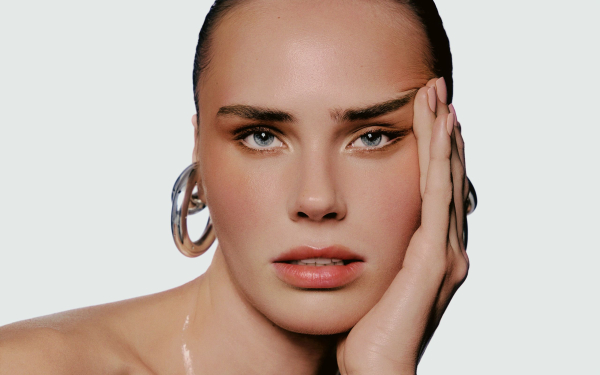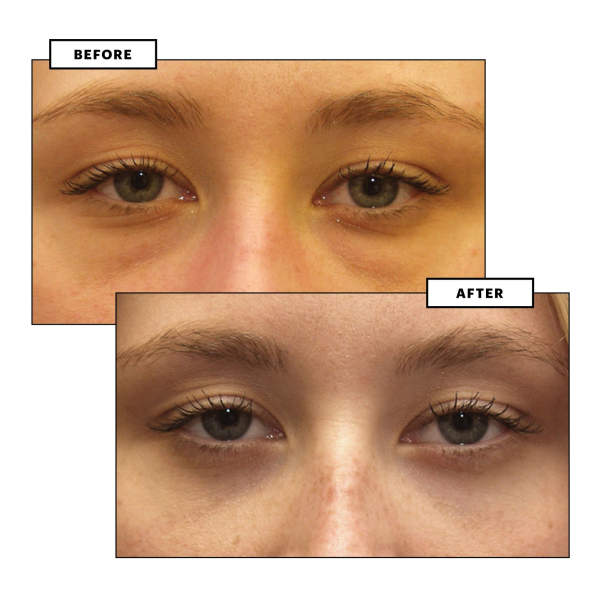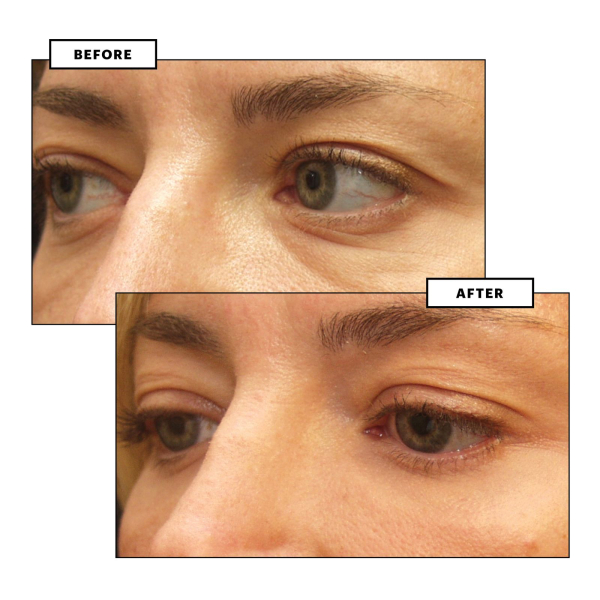 Huy LuongSave this storySave this story
Huy LuongSave this storySave this story
Lower blepharoplasty isn’t the sexiest sounding plastic surgery procedure around, but lately it’s getting a ton of attention in ORs and on social media—including from a new group of younger patients. Once reserved for removing sagging undereye bags and loose skin on the 60-year-old facelift set, lower blepharoplasty is now appealing to broader age groups, including patients in their 30s and even 20s, who want to get rid of chronic undereye puffiness and shadows that serums just can’t fix.
“This is not your mother’s bleph,” says Adam Kolker, MD, a double board-certified plastic surgeon in New York City. (“Bleph,” as you probably guessed, is shorthand for blepharoplasty.) Ten years ago, it was rare to see someone in their 30s inquiring about a lower blepharoplasty, but in the past few years, it’s become “incredibly common,” says Dr. Kolker. “People are their own harshest critics, and you're seeing your eyes in real time every time you take a selfie, every time you see yourself on Zoom or FaceTime. So I think people are hyperaware of shadows and bags, even in their 20s and 30s.” (Blepharoplasty, a catch-all term for tightening lower and upper lids, was one of the top five most popular plastic surgery procedures in the US last year, according to the American Society of Plastic Surgeons' most recent trend report. The report does not include numbers on patients' ages or on lower blepharoplasty specifically, though.)
Every time you look at a face, be it your own or someone else’s, it’s second nature to hone in on the eyes. “When we're having a conversation, the eyes are the main thing that we're focusing on; it’s the point of contact,” says Robert Schwarcz, MD, a board-certified oculoplastic surgeon in New York City, who specializes in blepharoplasty and performs about 30 to 40 each month. So it’s common to notice the most minute changes in your own eyes. “People say, ‘Oh, my neck is so bad,’ but it takes a minute to notice that. It doesn't take a minute to notice bags under the eyes,” says Dr. Schwarcz. “It's instantaneous.”
Ten years ago, it was rare to see a lower blepharoplasty patient in their 30s; now it’s “incredibly common.”
Lower blephs have also gotten a bump from the social media effect. There’s the speculation over which celebrities have had them—complete with some pretty compelling before and afters that make excellent (albeit speculative) cases for getting a surgery of your own. And there are also more and more millennial and Gen Z TikTok users documenting their lower blepharoplasties online, with some saying the procedure “changed [their] life.”
“With the rise of information on social media, people are asking for a surgical correction earlier,” says Jason Diamond, MD, a double board-certified facial plastic surgeon in Beverly Hills. Historically, patients started toying with the idea of a lower blepharoplasty around the age of 50, but Dr. Diamond says these conversations now generally begin as patients enter their 30s. This growing interest in lower blephs is also not limited to women. Dr. Schwarcz says more and more men are having the surgery: “Our patients are about 30% male, way up from previous years.”
These new lower blepharoplasty patients—both male and female—may have tried undereye filler or simply aren’t interested in injections, preferring to jump right to a much longer-lasting solution. Despite its promises and instant-gratification vibe (with just a needle, no more puffiness!), undereye filler has become a somewhat controversial procedure. It can be great for the right patient, but usually that's someone more interested in addressing chronic dark circles than prominent bags. “If someone strictly has hollowness [under their eyes], tear trough filler is a reasonable option to provide volume to an existing concavity,” says Dr. Diamond, but it also can carry the risk of lumps, bumps, and a bluish tint (called the Tyndall effect) in the thin skin of the undereye area. When an unskilled injector offers up undereye filler, the more serious side effects can even include blindness or stroke.
“This is not your mother’s blepharoplasty.”
So maybe it’s not so surprising that surgeons have noticed an increased “shifting away from short-lived injectable Band-Aids,” says Dr. Kolker. Filler has been criticized for the undereyes, adds Dr. Diamond, “because it hasn't always provided the results desired—and it’s caused worse counterproductive issues, when performed incorrectly.”
Patients in their 20s and 30s who are interested in lower blepharoplasty are typically looking to address bags and puffiness, or saying their eyes “look like their mom’s eyes,” says Dr. Schwarcz. In more technical terms, these younger patients are motivated by a desire to correct “a contour defect,” he adds. “Meaning there’s a puff and a drop, or a ‘mountain’ and a ‘valley’ under the eye.” For these patients, the puffiness is usually something that they were born with. It is genetic and has very little to do with age. The goal of their lower blepharoplasty is to “drop the peak of the mountain and raise the trough of the valley so they’re almost at the same height at the ‘cheek-eyelid’ junction,” Dr. Schwarcz explains, which is “the most important thing” to adjust if you want the area where the undereyes and cheeks meet to look smooth and less distinct. (This is generally the goal of lower blepharoplasty for older patients, too, but those also entail removing excess skin that is sagging or looks loose under the eye.)
In some ways, these new, younger patients may be better suited to lower blepharoplasty, technically speaking, than the more traditional middle-aged candidates. During a consultation for this particular surgery, a plastic surgeon often performs the “snap back test,” in which they gently pull the undereye skin away from the face to see how quickly it goes back into place. For patients who have loose, sagging skin, it might not snap back quickly. “It kind of falls in space,” says Patrick J. Byrne, MD, a board-certified plastic facial plastic surgeon and president of the American Academy of Facial Plastic and Reconstructive Surgery (AAFPRS). A lower blepharoplasty can still be performed, but it’s a bit more complicated. It requires techniques to tighten the corner of the eyes and support the lower lids, which can potentially lead to “very subtle changes in the shape of the eye,” says Dr. Byrne, typically an unwanted side effect. When you’re younger and your skin snaps back faster, you don’t need these additional surgical techniques that could potentially and regrettably wind up changing the shape of your eyes.
There can be a puff and a drop, or a ‘mountain’ and a ‘valley,’ under the eye that is genetic and has very little to do with age.
For more and more young patients, lower blepharoplasties are appealing for their ability to address puffiness that can simply be part of their anatomy (other times, puffiness can come with age). “Even at very young ages, you can have this contour imperfection underneath the eyes,” says Dr. Byrne. Lower lid puffiness and perpetual shadows are usually genetic and can be visible even in teenagers, but that’s not to suggest anyone hand out lower blepharoplasties as high school graduation gifts. Surgery-wise, you “generally want to think about addressing this when you've exhausted other options,” says Dr. Kolker.
A 32-year-old patient before and after lower blepharoplasty with fat grafting, performed by Robert Schwarcz, MD, a board-certified oculoplastic surgeon in New York City. Courtesy of Dr. Schwarcz.
A 24-year-old patient before and after lower blepharoplasty performed by Adam Kolker, MD, a double board-certified plastic surgeon in New York City. Courtesy of Dr. Kolker.
These other options include in-office tightening treatments (like CO2 lasers) or chemical peels to help smooth and tighten the lower lid. But scalpel-free options won’t always make a really appreciable difference. “The more puffiness, the less of a candidate they are for nonsurgical options to really improve their problem in an effective, long-lasting way,” says Dr. Diamond. Filler can’t do much to help prominent bags under the eyes, but “if a patient has subtle puffiness, adding filler to the surrounding area that's concave can bring those areas forward, reducing the appearance of the puffiness and making the area appear more smooth,” says Dr. Diamond. “You can do undereye filler in literally five minutes, and you can walk out and go to dinner that night. That suits a lot of people who are like, ‘I can't be out for a week. I've got to be ready tomorrow.’”
But like we said, undereye filler isn’t always a perfect solution, and you really need to go to someone who is deeply experienced—a board-certified plastic surgeon or dermatologist only, and ideally one who can show you a portfolio of compelling before and afters. And even then, sometimes filler can do more harm than good, says Konstantin Vasyukevich, MD, a board-certified plastic surgeon in New York City. In fact, he thinks undereye filler gone awry in younger patients might be one reason they’re asking about lower blepharoplasties. Dr. Vasyukevich has seen a “huge” uptick in patients dealing with “filler-related bags,” and most of them don’t realize it’s related to filler. “They just see it as puffiness,” he says, noting that’s partly because often it’s not being caused by recent filler—it’s old. “Something has been there for a year or even five years and can create puffiness under the eyes.” In these cases, dissolving the filler with hyaluronidase removes that puffiness entirely, without the need for surgery.
What’s not an option for bringing down lifelong puffiness and shadows under the eyes is skin care, says Melissa Doft, MD, a board-certified plastic surgeon in New York City. Despite all the claims of brightening and depuffing that eye creams and serums and rollerballs make, chronic bags or trough shadows (in the hollow underneath puffiness) are caused by fat pockets under the skin. “There's no cream that's going to get rid of the fat,” says Dr. Doft. No serum or mask or rollerball, either. “The only way is to surgically remove it, and Gen Z and millennials like the idea of one-and-done, which leads them to surgery over fillers.”
Lower blepharoplasty is considered an incredibly safe and minimally invasive procedure, which no doubt adds to its appeal. It is often performed under IV sedation or local anesthesia (not general anesthesia), and the recovery involves swelling and bruising for a week or two. Minor swelling may continue for a few weeks, and a patient will be fully healed in about three to six months. “It’s a pretty easy healing,” says Dr. Diamond, adding that usually patients describe it as “a painless recovery.” Potential risks can include lid lag, where the lower eyelid pulls down, and what Dr. Byrne calls “little bleeders” behind the eye, which can retract and cause complications; however, these are very rare. “You really need a controlled environment where you can have meticulous hemostasis control of those blood vessels to keep the patient safe,” he explains.
Though the recovery process is less intense than it is for many other facial procedures, targeting the lower lid comes with unique challenges and its own set of considerations. “The lower eyelid has a tougher job than the upper lid,” says Dr. Byrne. “It has to stay suspended upward sufficiently to protect the eye and allow tears to drain.” To address puffiness while avoiding surgical scars on such a prominent area of the face, all the surgeons I spoke with prefer a transconjunctival blepharoplasty approach, which is done through the inside of the eyelid (as opposed to below the lash line), thus leaving no visible trace. As Dr. Diamond explains it, a surgeon will trim down, reposition, or completely remove the fat pockets (there are three under each eye) or fold them over the rim of the eye. “When we shrink the fat pockets down, we’re completely reducing the puffiness,” he says.
A 33-year-old patient before and after lower blepharoplasty performed by Dr. Kolker. Courtesy of Dr. Kolker.
Sometimes, plastic surgeons will add more fat to the area. When a patient has puffiness and hollowness underneath the eyes, as many do, surgeons will use fat grafting to inject fat from the patient’s abdomen into that sunken area so the skin surface right under the eyes becomes an entirely even plane. Fat grafting has become an increasingly popular technique for adding tiny amounts of fat and volume where they’re needed in the face. It’s also useful for patients who are on a GLP-1, though that’s a bit more involved: “I need to graft more fat because their cheek and eyelid junction is way more sunken and hollow,” says Dr. Schwarcz.
A lower blepharoplasty can cost anywhere from $5,000 to $20,000, depending on the surgeon's location, anesthesia, the surgeon’s expertise, and whether or not fat grafting or laser treatments are performed, as well. The surgery usually takes a few hours, and while most younger patients get it as a standalone procedure, it can also be combined with other surgeries, like an upper bleph (which removes excess fat, muscle, and/or skin from the upper eyelid), a facelift, or a brow lift.
A lower blepharoplasty delivers smoother, refreshed undereyes, but no plastic surgery has permanent results. The aging process continues, says Dr. Kolker, regardless of whether or not a patient has gone under the knife. “Nothing lasts forever, even thoughtfully performed surgery,” he says, noting that “skin may loosen over time. A lower blepharoplasty done in your 20s or 30s to address puffiness can offer long-term improvement, but it won’t stop the clock.” But, “You’ll almost always look better than if you hadn’t had it.”
Read more about plastic surgery:
- Is "Skin Pinch" Surgery Actually a Quick Fix for Crepey Eyes?
- 17 People Get Real About Their Mommy Makeovers
- The "Glow-Up" Facelift Is Real




Leave a Reply